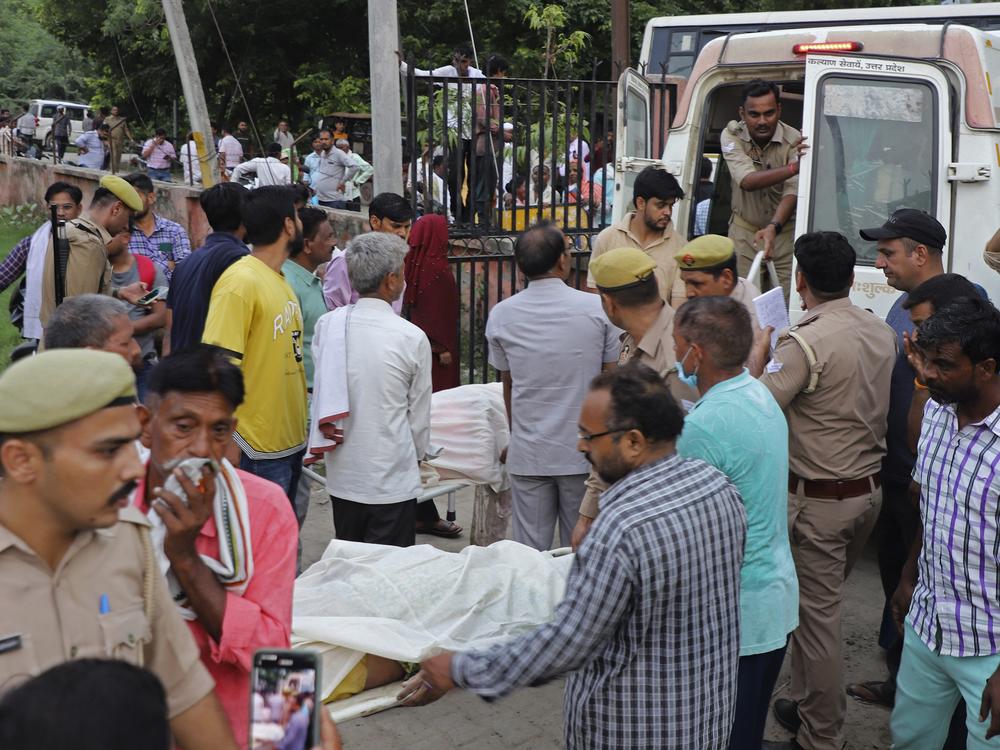Section Branding
Header Content
More than 120 people were killed in one of India's deadliest stampedes
Primary Content
MUMBAI, India — At least 121 people died in a stampede at a congregation of a Hindu religious preacher in the northern India town of Hathras on Tuesday, according to the Office of the Relief Commissioner for the area.
Most of the victims are women, according to a list of the confirmed fatalities.
While an official inquiry into the cause is still underway, two versions of events have emerged.
Yogi Adityanath, chief minister of Uttar Pradesh, the state where the stampede occurred, said it started after a group of devotees were stopped by organizers from coming close to the preacher.
Meanwhile, district administrator Ashish Kumar said the incident happened toward the end of the event, when people were trying to escape the heat and humidity inside the makeshift tent where the congregation was held.
By Tuesday evening local time, videos on social media showed bodies lying outside a local hospital. Some eyewitnesses told local media that the lack of crowd management at the exit points leading up to the main highway exacerbated the stampede.
According to a police complaint filed on Tuesday night, the organizers had sought permission for 80,000 people to attend but around 250,000 turned up at the venue.
"As the preacher left in his car, many rushed to collect dust rising from the path of the vehicle," a religious practice among some Hindus. "Some of those bent over got crushed by the large crowd exiting the venue," the complaint said.
It adds that the event organizers tried to destroy evidence of the stampede by throwing victims' clothes and footwear into neighboring fields.
The complaint is registered under sections related to culpable homicide not amounting to murder and destruction of evidence. It does not name the preacher, Surajpal, better known as "Bhole Baba," as one of the accused.
The government has announced compensation of an equivalent of $2,500 for the deceased persons’ families. Prime Minister Narendra Modi expressed condolences for the victims. In the Parliament, opposition leaders said responsibility for the tragedy lay with the government.
The stampede was the latest of such tragedies in India
India has a history of stampedes at religious gatherings, often because of little enforcement of safety measures. One of the biggest incidents in recent years occurred in 2013 after the railings of a concrete bridge leading to a pilgrim town in central India broke, killing 115 people and injuring more than 100.
The next year, India’s disaster management authority released a set of guidelines to prevent stampedes. It recommended measures for the government and private organizers to take, including putting up route maps, installing CCTV cameras, regulating traffic and setting up medical emergency camps.
Janki Andharia, a professor at the School of Disaster Studies at the Tata Institute of Social Sciences, says implementation of the guidelines has been patchy.
“Some pilgrim hotspots like Amarnath temple [in the Himalayas] and Tirupati temple [in India’s south] have robust crowd management systems,” she says. “But these are not uniformly implemented. And there is little cross-learning.”
Between 2005 and 2015, India had a string of stampedes at religious places, with hundreds of deaths. But this number seems to have fallen, according to government records.
Before the stampede on Tuesday, the last such deadly event was in 2022, when at least 12 people died after a huge crowd of devotees tried to enter the Vaishno Devi shrine in the state of Jammu and Kashmir.
Andharia cautions against taking the apparent reduction in death toll at face value. “Deaths due to stampede are often underreported," she said. "Unfortunately, human life has scant regard in our country.”

